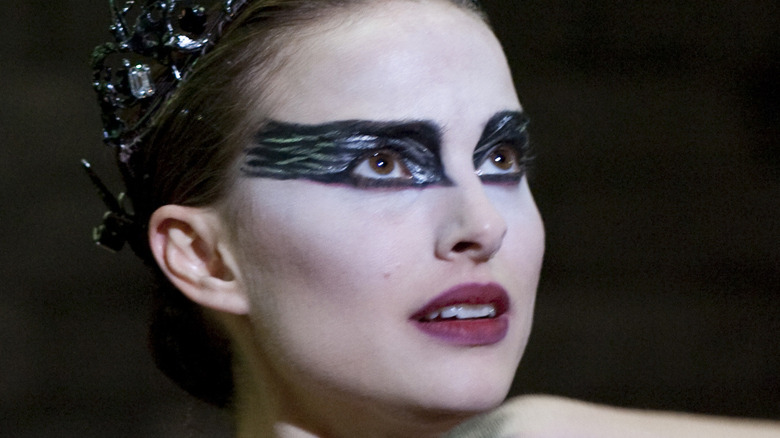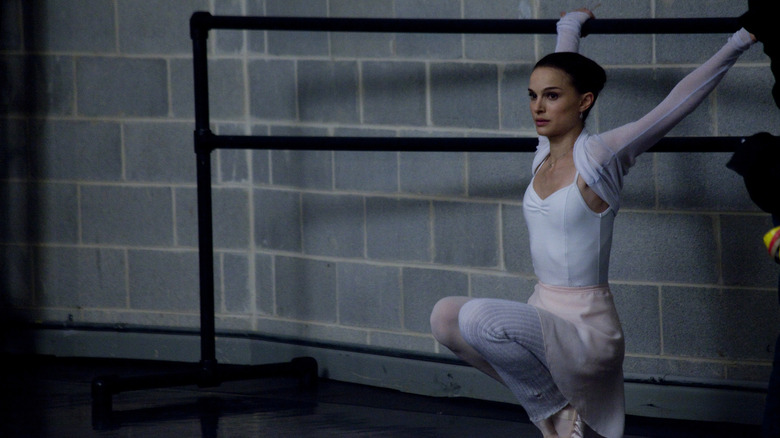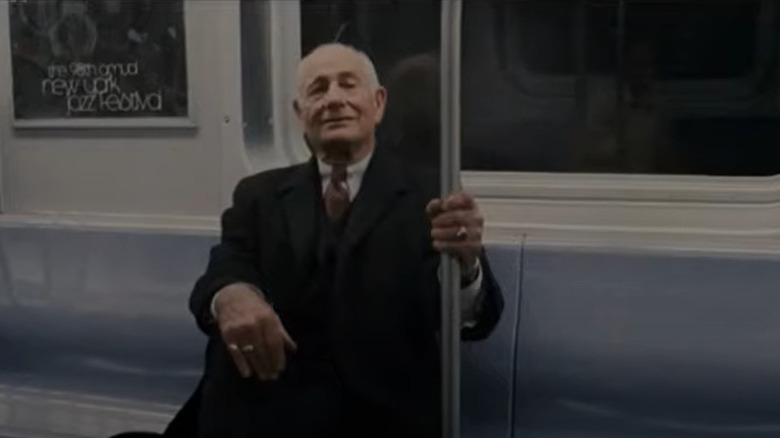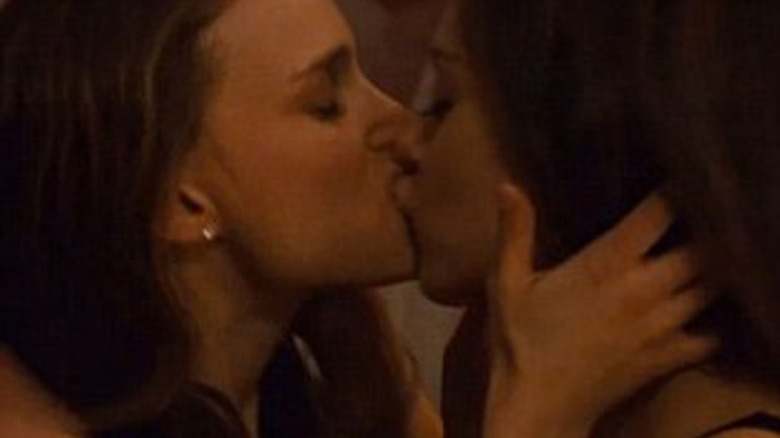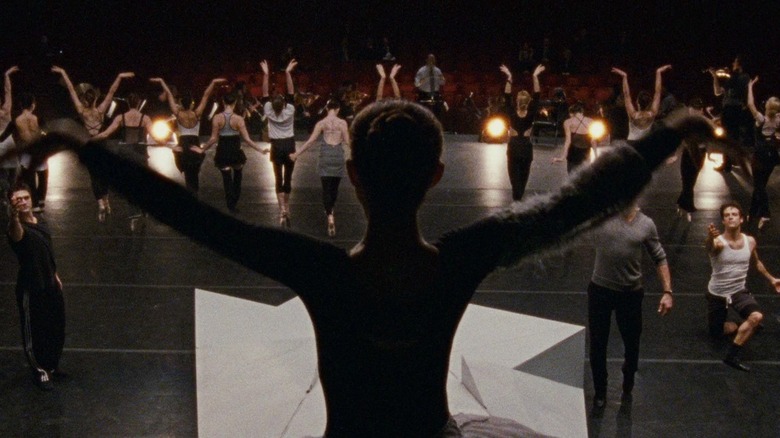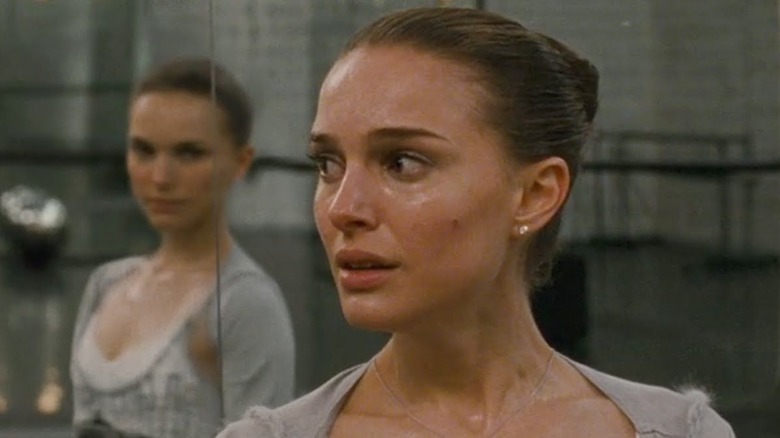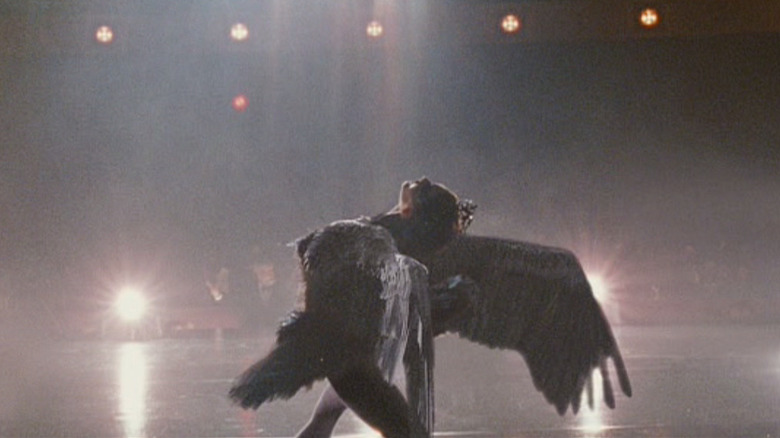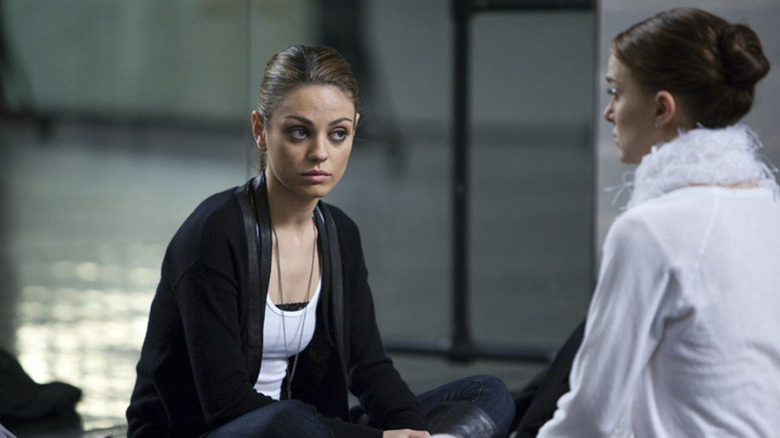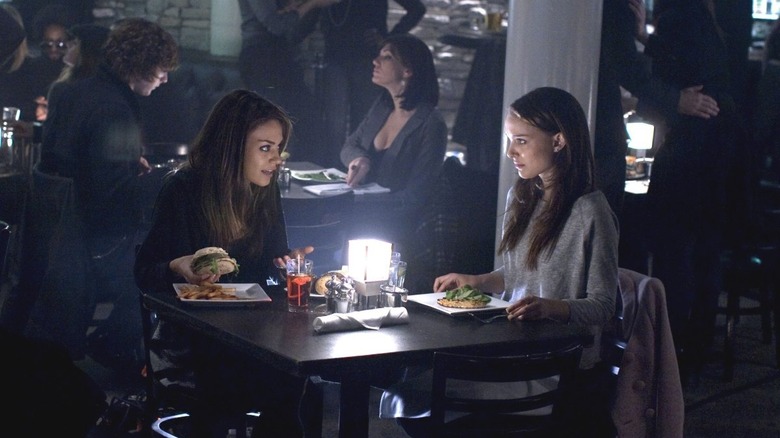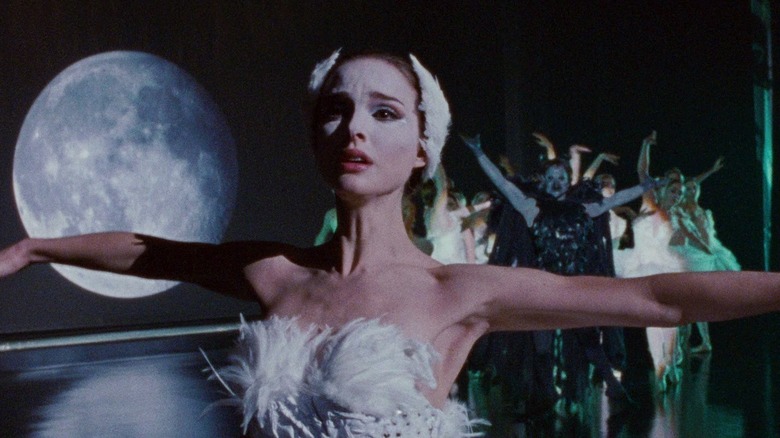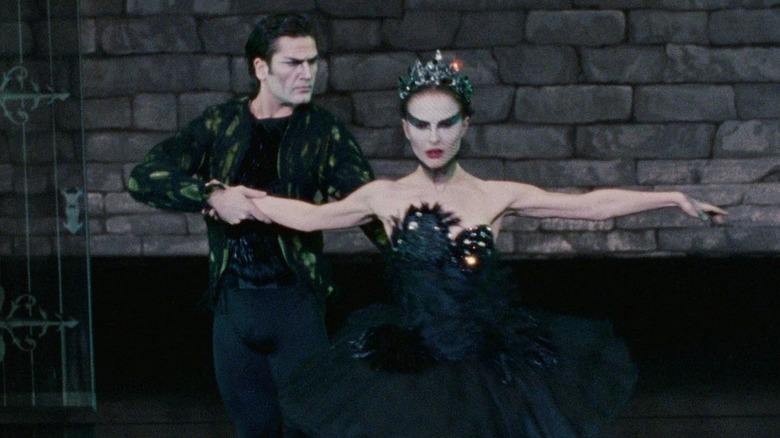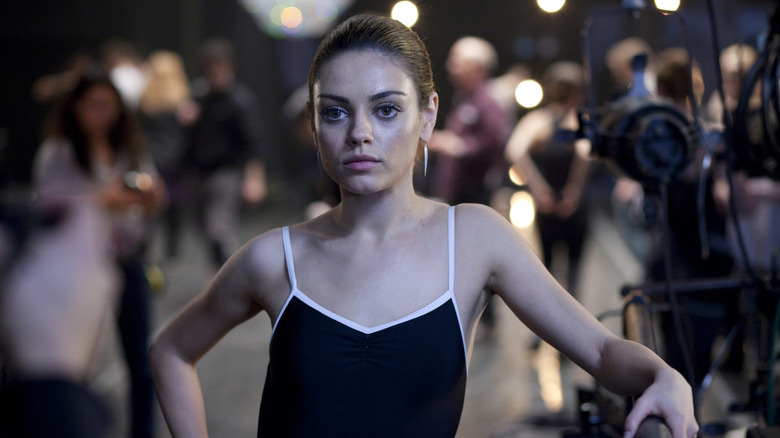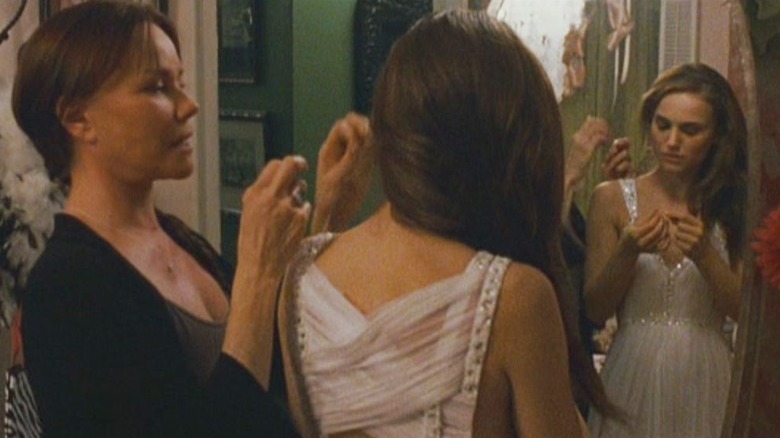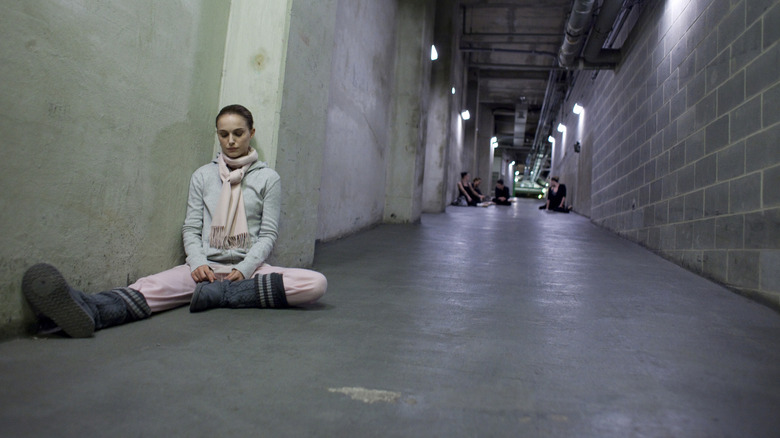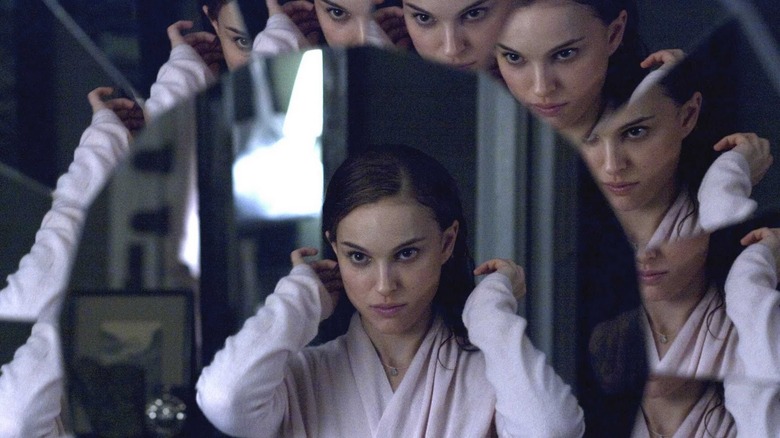Black Swan Facts That Won't Play Tricks With Your Mind
Filmmaker Darren Aronofsky is well known as a purveyor of challenging cinema. From "Requiem for a Dream" to "The Wrestler," Aronofsky's movies tend to focus on dark and disturbing subjects with laser-like precision, uncovering the murky realities of the private lives of people dealing with addiction and obsession.
Another movie that Aronofsky made in a similar vein was 2010's "Black Swan." The film follows the story of an ambitious ballerina named Nina (Natalie Portman) who works with the New York City Ballet company. After being considered for a starring role in an important stage play, Nina finds her life being turned upside down and spiraling out of control as she fights to safeguard the biggest break of her career.
"Black Swan" was a big hit at the box office upon release. It was also hailed by the critics for its screenplay and performances while being nominated for (and winning) a bunch of major awards. Let us take a look at some lesser-known facts behind the concept and development of "Black Swan."
It's an unofficial companion to The Wrestler
Darren Aronofsky's 2008 film "The Wrestler" tells the story of a man who puts himself through hell for the sake of his wrestling career, and is rewarded with great damage being done to his mind and body. Similarly, "Black Swan" tells the story of a woman who puts herself through extreme trials for the sake of her ballet career and consequently suffers from severe mental and physical issues.
Many fans have noted the similarities between the plot and themes of "The Wrestler" and "Black Swan," and this is no coincidence. Aronofsky initially conceived the two stories as a single project. "Way before I made "The Wrestler," I was actually developing a project that was about a love affair between a ballet dancer and a wrestler," the filmmaker told MTV. "And then it kind of split off into two movies."
Aronofsky explained in the same interview that while wrestling is often considered "low art" and ballet is considered "high art," the two make similar demands of their performers, and take similar tolls on their bodies. The filmmaker also revealed that he would like "The Wrestler" and "Black Swan" to be screened as back-to-back features since they are "companion pieces."
The Uncle Hank cinematic universe
These days every studio wants to create their own series of interconnected movies making up an entire cinematic universe. But this idea of connecting various films through common characters is not new. In fact, auteur filmmakers like Quentin Tarantino often like to pepper in characters from their previous movies as Easter eggs for eagle-eyed fans.
Case in point: "Black Swan" features a scene in which an old man pleasures himself on the subway next to Nina. Fans of Darren Aronofsky's earlier works might recognize the man as the same guy who sang "ass-to-ass" in "Requiem for a Dream." The man has a name, and it is Uncle Hank. The character is played by Stanley B. Herman in both movies — although he had a much more significant role in "Requiem for a Dream."
So can we assume that the events of "Requiem for a Dream" and "Black Swan" take place in the same reality? Possibly so. Since "The Wrestler" and "Black Swan" are also seen as companion pieces by Aronofsky, perhaps all three movies exist within the same cinematic universe, with the character of Uncle Hank being the glue that holds the entire structure together with his brief appearances.
They needed that kiss
In "Black Swan," the main character Nina feels triumphant when she is selected to play the lead in a ballet stage production of Tchaikovsky's "Swan Lake." Soon after, Nina learns that a new ballerina named Lily (Mila Kunis) has been selected to play her character's counterpart as a dark and sensual mirror image.
Nina begins to feel threatened by the confidence and talent Lily brings to the table. The most famous scene between Nina and Lily occurs when they share a kiss in the middle of their rivalry. The kiss became a major talking point in the days leading up to the release of "Black Swan," and that was something the makers of the movie were actually banking on to get audiences into the theater.
"Everyone was so worried about who was going to want to see this movie," Natalie Portman told Entertainment Weekly. "I remember [the producers] being like, 'How do you get guys to a ballet movie? How do you get girls to a thriller?' And the answer is a lesbian scene. Everyone wants to see that." Nowadays, such queerbaiting tactics are frowned upon, but the strategy appeared to work in favor of "Black Swan," which ended up doing massive numbers at the box office.
Suffering for the art
While filmmaker Darren Aronofsky has often received critical acclaim for his films, he has never been viewed as a blockbuster hitmaker. That is why Aronofsky struggled to get funding to make "Black Swan." In the end, the studio agreed to cough up a minuscule amount of money with which to make the film on a shoestring budget.
Things got so tight in terms of finances that the actors had to make certain sacrifices to keep the production going. For example, as a lead actor in many big-budget blockbusters, Natalie Portman was used to certain amenities on set — you know, like a medic to help during emergencies — but the actress realized things were going to be done differently for "Black Swan" when she suffered a rib dislocation and there was no one on hand to tend to her injury.
"It's funny because when I got injured I called the producer, I was like 'Could you get the medic? I need an ice pack or something right now,'" Portman told David Letterman. "And he was like, 'Oh, we don't have a medic because it's super low budget.'" The actress mentioned that this was the first time in her 20-year career that she was told there was no medic on a film set. Portman told the producer to get a medic, even if they have to take away her trailer instead to cut costs. The next day, she discovered that her trailer had indeed been removed.
It was originally titled The Understudy
Filmmaking in Hollywood is never a straightforward process. Every year, scores of new scripts are written, and they sometimes lie around production houses for years before being dusted off, heavily rewritten, and then changed some more before finally being turned into a film.
That is also what happened with "Black Swan." In 2000, filmmaker Darren Aronofsky was working on "Requiem for a Dream" and was already looking for a new subject matter for his next project and was inspired by a viewing of "Swan Lake" and a reading of "The Double" by Fyodor Dostoevsky. "Right about the same time this script came around, when I was editing 'Requiem for a Dream,' called 'The Understudy,' by Andres Heinz," Aronofsky told IndieWire. "It was 'All About Eve' with a double, set in the off-Broadway world."
Although the filmmaker tried to get hired to make the script into a film, the studio passed him over at the time. Years later, "The Understudy" was still stuck in development limbo. That was when Aronofsky brought in writer John McLaughlin to incorporate certain ideas the filmmaker had about a thriller set in the world of ballet into "The Understudy." After even more struggles to find a studio that would back the project, and another rewrite by Mark Heyman, "The Understudy" finally went into production under the retitled name "Black Swan."
Pulling from her personal knowledge
Aside from starring in many successful movies, Natalie Portman is also known for being one of the most academically inclined celebrities in Hollywood. The actress studied psychology at Harvard University and graduated in 2003 with a bachelor's degree. This kind of background proved useful for making "Black Swan."
"[Playing the lead in 'Black Swan'] was actually a case where something I learned in school did translate into something practical in life," Portman told Collider. The actress went on to explain that she was able to draw on her knowledge of psychology to create a map of her character Nina's mental makeup and the reasoning behind her many self-destructive habits.
"[Nina suffers from] a case of obsessive-compulsive behavior," Portman said. "The scratching and the anorexia and bulimia [Nina showcases] are forms of OCD." The actress also points out that the many rituals found in ballet like breaking into new shoes would appeal to Nina's OCD compulsions, as would the desire to treat ballet with something akin to ritualistic, religious fervor, and her company's director as a god-like being who demands complete and total devotion from his acolytes.
If you or someone you know needs help with mental health, please contact the Crisis Text Line by texting HOME to 741741, call the National Alliance on Mental Illness helpline at 1-800-950-NAMI (6264), or visit the National Institute of Mental Health website.
Bringing Mila Kunis into the picture
At the time of the release of "Black Swan," Mila Kunis was best known for her role as Jackie on the hit comedy series "That '70s Show." Kunis used that fame to parlay a successful career in romantic and comedy film and television projects. Playing Lily in "Black Swan" was a big departure from her previous roles.
While Lily is not the main villain in the film, she is an important part of the proceedings and the major reason for Nina's descent. When it was time to cast an actress in Lily's role, it was Natalie Portman herself who came up with the suggestion of having Kunis play the role. According to a report by The Independent, Portman recommended Kunis to Darren Aronofsky and then found out the filmmaker was already thinking of the same actress for Lily's role.
"Black Swan is the first time where a brilliant movie was handed to me," Kunis said of the role, explaining how Aronofsky had been mightily impressed by her acting in "Forgetting Sarah Marshall." So much so that Aronofsky did not even audition Kunis to play Lily but simply offered her the part after a few conversations. That trust in Kunis' ability proved well-placed, as the actress received a lot of praise for her acting in "Black Swan."
Natalie Portman vs. Mila Kunis
"Black Swan" is as much of a psychological thriller as it is a horror drama. Most of the film is an exploration of its lead character Nina's damaged psyche, which starts to unwind when Nina is confronted by her rival, the confident and sensual Lily. The dynamic between Nina and Lily forms the basis for the film's chief dramatic conflict.
This conflict gets played out in many scenes where you can see the animosity between the two characters in their personal and professional interactions. Director Darren Aronofsky wanted to make sure the animosity came from a real place. To that end, he actively tried to turn Natalie Portman against Mila Kunis while shooting the movie. "Darren would tell us things about each other to try to make us jealous," Portman told Vogue. "I think he was trying to create a rivalry in real life between us."
The plan did not work out because Portman and Kunis were already good friends who felt no desire to get competitive on set. Aronofsky also tried a different strategy where he kept the two actresses apart while shooting. "I just didn't want them to know each other's motives," the filmmaker explained in the same interview. "I didn't want them to compare notes. I wanted them to come from different places."
Working hard for the role
Natalie Portman is no stranger to doing roles in action movies, but "Black Swan" provided a different kind of challenge. Here, the focus was on looking like a professional ballerina, which meant not only learning ballet but drastically changing her body and mental makeup in order to convincingly portray the lead character of Nina.
Portman's preparations for playing her role started a full year before the cameras ever began rolling on "Black Swan." "It was about a year of ballet preparation that sort of ramped up as the film got closer," the actress explained to Vanity Fair. "It started out for a couple of hours a day, then five hours a day, then more like eight hours."
While the ballet training was hard enough, things got a lot more serious while filming the climactic scene in the movie where Nina fights her doppelganger. According to Portman, she got so engrossed in the action choreography that she hit herself hard on the head. The shooting had to stall while the actress was rushed to the hospital for an MRI scan. Fortunately, there were no lasting injuries and Portman was able to resume the shoot soon afterward.
The dance controversy
"Black Swan" was Natalie Portman's bold bid for Oscar glory. In the days leading up to the Academy Awards ceremony, Portman gave many interviews stressing the lengths she went to in order to embody the character of Nina, including losing drastic amounts of weight, training in ballet for multiple hours every day, and doing her own dance sequences in the film.
This last part became the subject of some controversy when Sarah Lane, Portman's body double for the movie, came out with accusations that her dance performances in the movie had been unfairly credited to Portman. "Of the full body shots [in the dance scenes], I would say 5 percent are Natalie," Lane told Entertainment Weekly. "All the other shots are me." She further added that the film's makers wanted to project the image of Portman as some kind of dancing prodigy who mastered the art in a short span of time when in reality it takes decades of work to become so good at ballet.
The controversy became big enough that director Darren Aronofsky had to release a statement in Portman's defense. "I had my editor count shots," the filmmaker wrote in his statement reported by HuffPost. "There are 139 dance shots in the film. 111 are Natalie Portman untouched. 28 are her dance double Sarah Lane. If you do the math that's 80% Natalie Portman." Aronofsky further states that 90% of the dancing in scenes according to their duration are performed by Portman, while Lane's dancing scenes usually only last a few seconds on camera.
Battling nicotine dependence
Broadly speaking, the character of Lily in "Black Swan" is meant to be the "bad girl" of the ballet world, a sexually liberated, hard-drinking, and smoking outsider who threatens the position of the demure and virginal main character Nina. In order to portray Lily's libertine nature, Mila Kunis had to form some deeply unhealthy habits.
One of the methods of preparation necessitated losing a bunch of weight. While many actors take their time with weight loss under careful supervision by medical professionals, Kunis took a much more straightforward route of cutting down dramatically on her meals and replacing food with nicotine. "I smoked a lot of cigarettes and I ate a limited amount of calories," the actress told Howard Stern (via Yahoo). "It was a 1200-or-less calorie diet a day... And I smoked. I don't advocate this at all."
As far as preparing for the movie goes, Kunis achieved her goal of losing an enormous amount of weight in a short period of time. Once filming wrapped the actress was finally able to quit her nicotine habit, which she called "the best decision I ever made in my life."
Real letters of support
"Black Swan" is a meditation on the effect that single-minded dedication can have on a person. Nina is someone who is shown to be starved of love and affection at her workplace, and the competitive atmosphere sends her spiraling out of control to the point where she ends up doing lasting harm to her mind and body.
In such a scenario you can't help but feel Nina could have benefitted from someone showing genuine care for her. The movie has Barbara Hershey in the role of Nina's mother Erica, who seems to be extremely protective of her daughter to the point where it feels like she is suffocating Nina by placing so many restrictions upon her. But off-camera the Erica/Nina dynamic was much more emotionally fulfilling. In an interview with Collider, Natalie Portman revealed that director Darren Aronofsky had Hershey write her letters in-character as Erica.
"[Darren] would hand [the letters] to me on important days of shooting that I should feel my mother," Portman explained. "Barbara wrote really gorgeous letters that were in character and really gave a sense of our history, our love and our connection." This supportive relationship runs counter to the narrative that many viewers attach to Erica in "Black Swan" as an ex-ballerina with a failed career trying to recapture her glory days by ruthlessly pushing her child to achieve what she could not in the field, leading to Nina's mental unwellness.
Natalie Portman was surprised by the final cut of the movie
Few people could have imagined "Black Swan" would become as big a hit as it did. The deep exploration of the relatively obscure ballet world, the strange style of direction specially designed to throw audiences off the scent, and the depressing, open-ended nature of the climax did not seem like a recipe for a global blockbuster.
As it turns out, Natalie Portman also did not think the movie was going to turn out the way it did. In fact, she thought they were making a completely different, much more grounded style of film during the shoot. "When I saw the final cut, I was completely surprised by what the movie was like," the actress told Vanity Fair (via IndieWire). "I thought we were shooting something like almost documentary style, and then I watched it and it was an over-the-top thriller."
Portman further stated that the experience confirmed her notion that film is essentially a director's medium, and it is possible for actors to finish a movie and still be completely in the dark as to how the final product will look and feel. Still, the actress recalled making "Black Swan" as an "incredible experience," calling director Darren Aronofsky an excellent collaborator who made Portman feel like a genuine partner on the project.
Plagiarism accusations
"Black Swan" was that rare small-budget, indie-like feature that set fire to the international box office and gathered up a slew of honors during award season. But the film also had to battle a fair amount of controversy with regards to its story and direction style, which to a number of critics seemed to be copied from previous movies.
For instance, "The Red Shoes," a 1948 British drama film about a ballerina who is given a huge opportunity at her new ballet company, but is forced by her director to choose between her career and her personal life to test her dedication to the craft. While the overarching plot shares many similarities with "Black Swan," Darren Aronofsky denied any direct influence. "I saw that there were similarities in the story," the filmmaker told Collider. "But I think that's because we both went back to ballet and pulled from ballet for the different characters and stuff, so we ended up in similar places."
A number of fans also pointed out that the composition and direction of several scenes appeared directly lifted from the 1997 anime classic "Perfect Blue." Once again, while Aronofsky admitted to having watched "Perfect Blue" and acknowledged the similarity between certain shots, he denied all accusations of plagiarism, stating that "There are similarities between the films, but [Black Swan] wasn't influenced by [Perfect Blue]."
